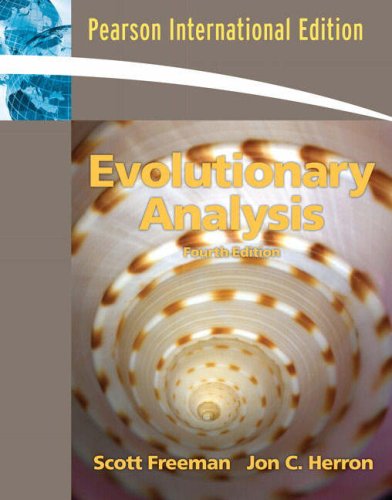Evolutionary Analysis: AND Animal Behaviour, Mechanism, Development, Function and Evolution - Softcover

This book presents evolution as a process, emphasizing the interplay between theory, observation, testing, and interpretation. The book conveys the excitement and logic of evolutionary science through the use of real-world applications. For anyone interested in the dynamic study of evolution.
"synopsis" may belong to another edition of this title.
The aims and audience of Evolutionary Analysis have not changed from the first edition to the second. Our goal is still to help students learn how to think like evolutionary biologists. The presentation is intended for undergraduates who are majoring in the biological sciences in preparation for careers in medicine, conservation, education, science journalism, or research. We assume that our readers have finished their introductory coursework and are ready to explore how a course in evolutionary biology can enrich their personal and professional lives.
Our approach and philosophy are also unchanged. Our tack is to present the topics that form the core of evolutionary biology in the same spirit of inquiry that drives research. Wherever possible, we motivate the material with the types of questions that evolutionary biologists ask. Are humans more closely related to chimpanzees or gorillas? If people with the CCR5-32 mutation are resistant to infection by HIV, will this allele increase in frequency in populations afflicted by the AIDS epidemic? Why did the dinosaurs suddenly go extinct, after dominating the land vertebrates for over 150 million years? Often a theoretical treatment will help to focus these questions, generate hypotheses, and make predictions that can be tested. After introducing the experiments and observations that biologists have used to test competing hypotheses, we analyze the data that resulted and consider what work remains to be done. Throughout the book, our objective is to present evolutionary biology as a dynamic and increasingly interdisciplinary enterprise.
Although the fundamental premise and approach of the book have not changed, its organization has. To align the sequence of chapters more closely with the way that most professors teach the course, we have reorganized the chapters into five units:
Part I, Introduction, demonstrates why evolution is relevant to real-world problems, establishes the fact of evolution, and presents natural selection as an observable process. Part II, Mechanisms of Evolutionary Change, develops the theoretical underpinnings of the Modern Synthesis by exploring how mutation, selection, migration, and drift produce evolutionary change. The population genetics coverage is dramatically expanded from the first edition, but simplified by the placement of most algebraic treatments in boxes. These chapters have also been enriched by an increased focus on how population and quantitative genetic models can be applied to real-life problems in medicine and conservation. Part III, Adaptation, is a new unit that begins by introducing methods for studying adaptation, and follows up by offering detailed investigations into sexual selection, kin selection, and selection on life history characters. Part IV, The History of Life, starts with an analysis of speciation and phylogeny inference methods. Subsequent chapters focus on Precambrian evolution, the Phanerozoic, and human evolution. Part V, Current Research—A Sampler, includes a chapter treating classical and recent topics in molecular evolution. The unit also contains two new chapters. One of these focuses on evolutionary insights that have emerged from advances in developmental genetics; the other explores applications of evolutionary biology in epidemiology, medical physiology, human behavior, and public health.
As in the first edition, most chapters include boxes that cover special topics or methods, provide more detailed analyses, or offer derivations of equations. All chapters end with a set of questions that encourage students to review the material, apply concepts to new issues, and explore the primary literature. Website and Transparencies
The companion website for Evolutionary Analysis has been revised and expanded. Each unit now includes two case studies. These tutorials challenge students to pose questions, formulate hypotheses, design experiments, analyze data, and draw conclusions. A tutorial for population genetics features problems students can solve using a downloadable simulation. The website also provides answers to selected end-of-chapter questions, guides to exploring the literature, links to other evolution-related sites, and an opportunity to email us with suggestions and comments.
The website for Evolutionary Analysis is accessible through the book's homepage at prenhall/freeman.
Prentice Hall's commitment to a four-color format for this edition of Evolutionary Analysis has enabled us to make the diagrams, data graphics, and photographs easier to interpret and the overall presentation brighter and more accessible. In response to requests from professors using the first edition, a set of 100 full-color overhead transparencies has been developed for the second edition. All transparencies are labeled with large, boldface type for easy reading in the classroom. Professors can get the transparency set by contacting either their local Prentice Hall representative, or Prentice Hall faculty services at (800) 526-0485.
"About this title" may belong to another edition of this title.
- PublisherAddison Wesley
- Publication date2007
- ISBN 10 1405892854
- ISBN 13 9781405892858
- BindingPaperback
(No Available Copies)
Search Books: Create a WantIf you know the book but cannot find it on AbeBooks, we can automatically search for it on your behalf as new inventory is added. If it is added to AbeBooks by one of our member booksellers, we will notify you!
Create a Want
